Yarn weight chart is your ultimate companion when selecting the yarn for any knitting or crochet project. This critical step lays the foundation for creating a masterpiece that’s not only visually appealing but also of the right size. With options ranging from delicate lace weight to cozy jumbo yarn, the world of yarn offers a wide array of choices.
Understanding yarn weights can be confusing, especially if you’re a beginner knitter or crocheter. In this comprehensive guide, I will share the basics you need to know about yarn weights in a simple and understandable way.
In addition, you will get a handy yarn weight chart and practical tips to assist you in selecting the perfect yarn for your next creative project.
Let’s get started!
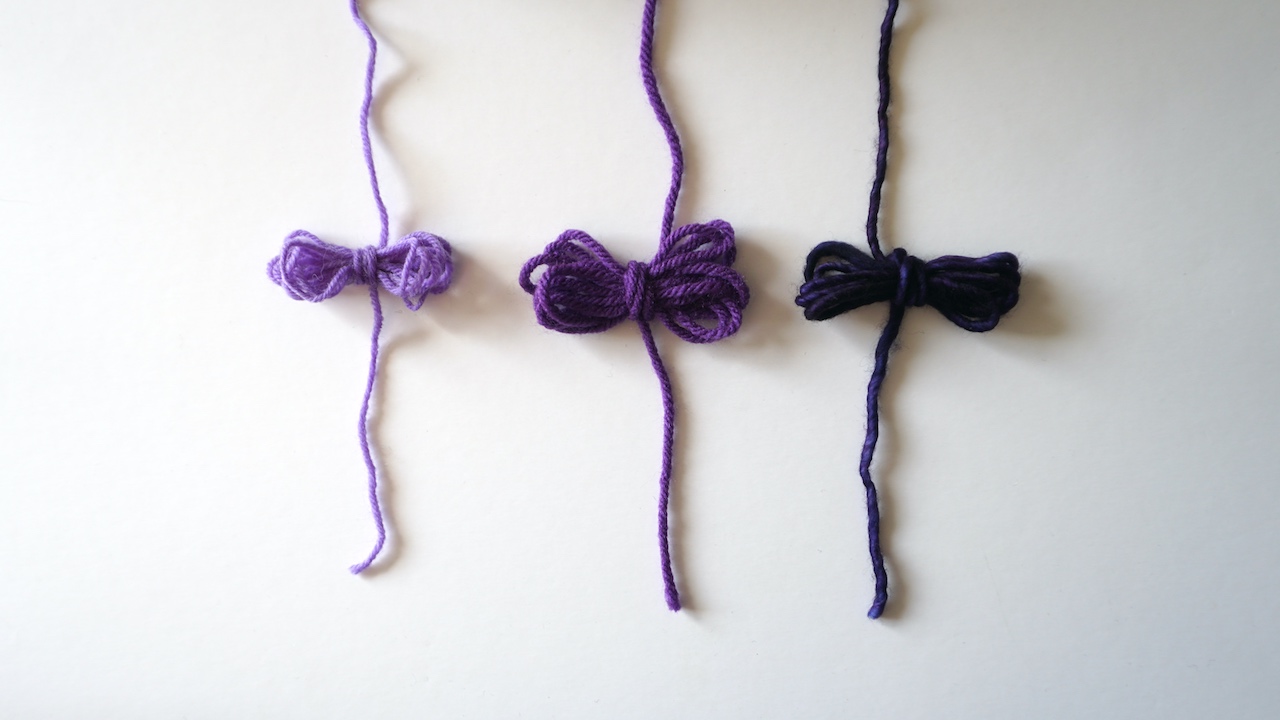
Understanding Yarn Weight
Yarn weight is one of the most important factors to consider when choosing yarn for any knitting or crochet project. It’s the key to achieving the desired size, texture, drape, and warmth in your projects.
Although we speak about yarn weight, it doesn’t actually refer to the actual weight of the yarn. Instead, yarn weight indicates the thickness or diameter of the yarn strand.
Recognizing and understanding the characteristics of each yarn weight is pivotal as each of them have their unique traits.
Exploring Yarn Weight Categories
In general, yarns are divided into eight different yarn weight categories, which are universally recognized in the knitting world. These categories are labeled with the numbers 0 through 7 and they encompass a spectrum of yarn thicknesses. The higher the number, the thicker the yarn.
Lace yarn (0) corresponds to the finest category, akin to 10-count crochet thread. Super fine yarn (1), also known as fingering or sock weight, adds an elegant touch, suitable for delicate projects. Fine yarn (2), which includes baby and sport weights, strikes a balance between delicacy and versatility. Light yarn (3), encompassing DK and light worsted weights, is ideal for lightweight wearables.
Moving on to medium yarn (4), it covers worsted, afghan, and aran weights, providing a versatile option for various projects. Bulky yarn (5), falling in the chunky and bulky categories, works up quickly, making it perfect for cozy winter accessories and chunky cardigans.
Super bulky yarn (6), which includes super chunky weight, is excellent for swift and warm projects like blankets and scarves. Finally, jumbo yarn (7) reigns as the thickest yarn and covers roving yarns. Typically, it is used for projects such as home decor projects and accessories, like blankets, as well as for arm-knitting projects.
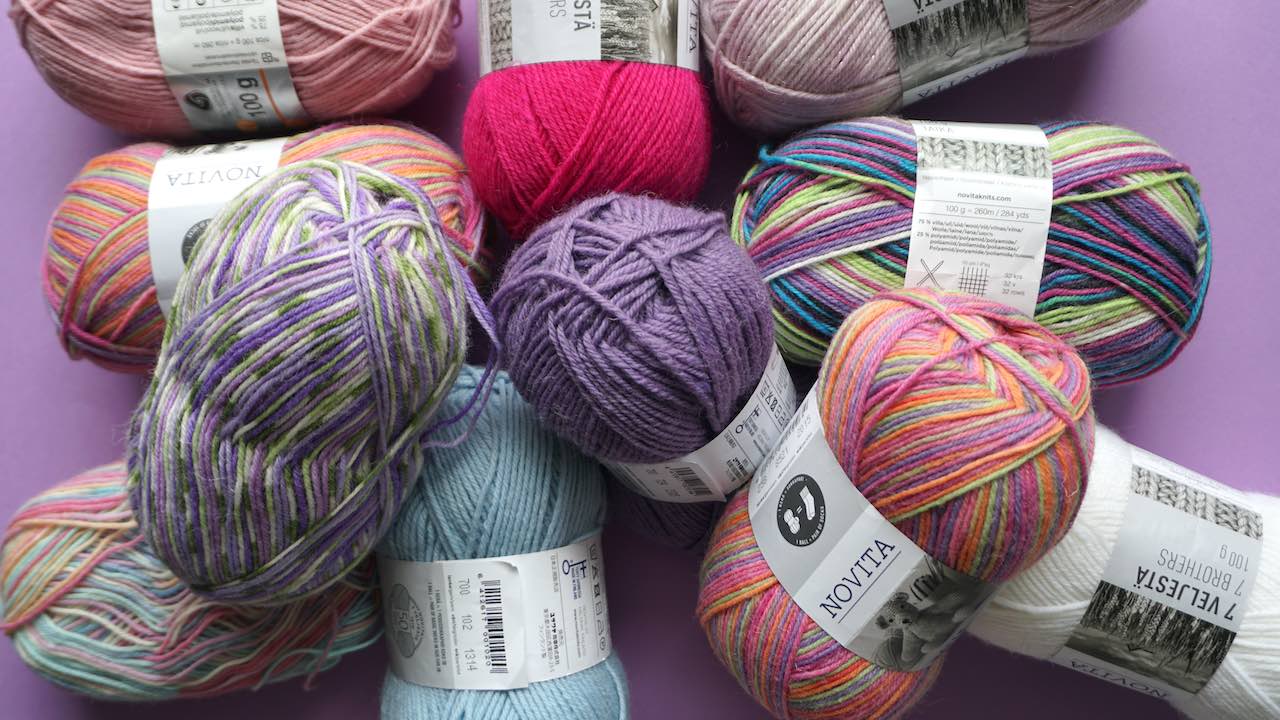
Yarn Weight Conversion Chart
When faced with patterns using different regional or weight standards, a yarn weight conversion chart is your invaluable ally. This tool effortlessly translates yarn weights between systems, ensuring your project materializes as envisioned.
| Yarn Weight Category | Symbol | Equivalent Categories |
|---|---|---|
| Lace | 0 | Thread, Cobweb, Light Fingering |
| Super Fine | 1 | Fingering, Baby, Sock |
| Fine | 2 | Baby, Sport |
| Light | 3 | DK, Light Worsted |
| Medium | 4 | Worsted, Afghan, Aran |
| Bulky | 5 | Chunky, Craft, Rug |
| Super Bulky | 6 | Super Chunky, Roving |
| Jumbo | 7 | Roving |
Typically, conversion charts encompass common yarn weight categories and their equivalents in diverse standards, such as UK, US, and international systems. With the help of this handy chart, you can confidently substitute yarns, whether adapting a foreign pattern or broadening your yarn horizons.
Yarn Weight Chart
Yarn weight or yarn thickness charts visually categorize yarns into standard weight categories, providing insight into their relative thickness. They offer a clear comparison between options, allowing you to make informed choices based on your project’s requirements.
This yarn weight chart below describes the yarn weight category, typical projects for the yarn weight in question, as well as the recommended needle and hook size. This way, you can easily compare different yarn weights and choose the yarn that best fits your knitting or crochet project.
| Yarn Weight Category | Description | Recommended Needle Size | Recommended Hook Size | Typical Projects |
|---|---|---|---|---|
| Lace | Delicate and thin, perfect for intricate lace patterns | US 000–1 (1.5–2.25 mm) | Steel 6, 7, 8 or B-1 (Steel 1.6–1.4 mm or 2.25 mm) | Lace shawls, delicate accessories |
| Super Fine | Slightly heavier than laceweight, great for lightweight garments | US 1–3 (2.25–3.25 mm) | B-1 to E-4 (2.25–3.5 mm) | Socks, lightweight scarves, baby clothes |
| Fine | Versatile choice for lightweight sweaters and baby items | US 3–5 (3.25–3.75 mm) | E-4 to 7 (3.5–4.5 mm) | Baby clothes, lightweight sweaters |
| Light | Slightly heavier than fine weight, ideal for lightweight wearables | US 5–7 (3.75–4.5 mm) | 7 to I-9 (4.5–5.5 mm) | Sweaters, hats, scarves, baby clothes |
| Medium | Go-to weight for different types of projects, “all purpose” yarn | US 7–9 (4.5–5.5 mm) | I-9 to K-10 1⁄2 (5.5–6.5 mm) | Scarves, sweaters, hats, blankets |
| Bulky | Quick to work up, excellent for cozy winter accessories | US 9–11 (5.5–8 mm) | K-10 1⁄2 to M-13 (6.5–9 mm) | Chunky scarves, hats, cardigans |
| Super Bulky | Some of the heaviest of yarns, great for fast, warm projects | US 11–17 (8 mm–12.75) | M-13 to Q (9–15 mm) | Hats, scarves, blankets |
| Jumbo | Heaviest weight of yarn, also used for arm-knitting projects | US 17 and up (12.75 mm and up) | Q and up (15 mm and up) | Blankets, home decor projects, accessories |
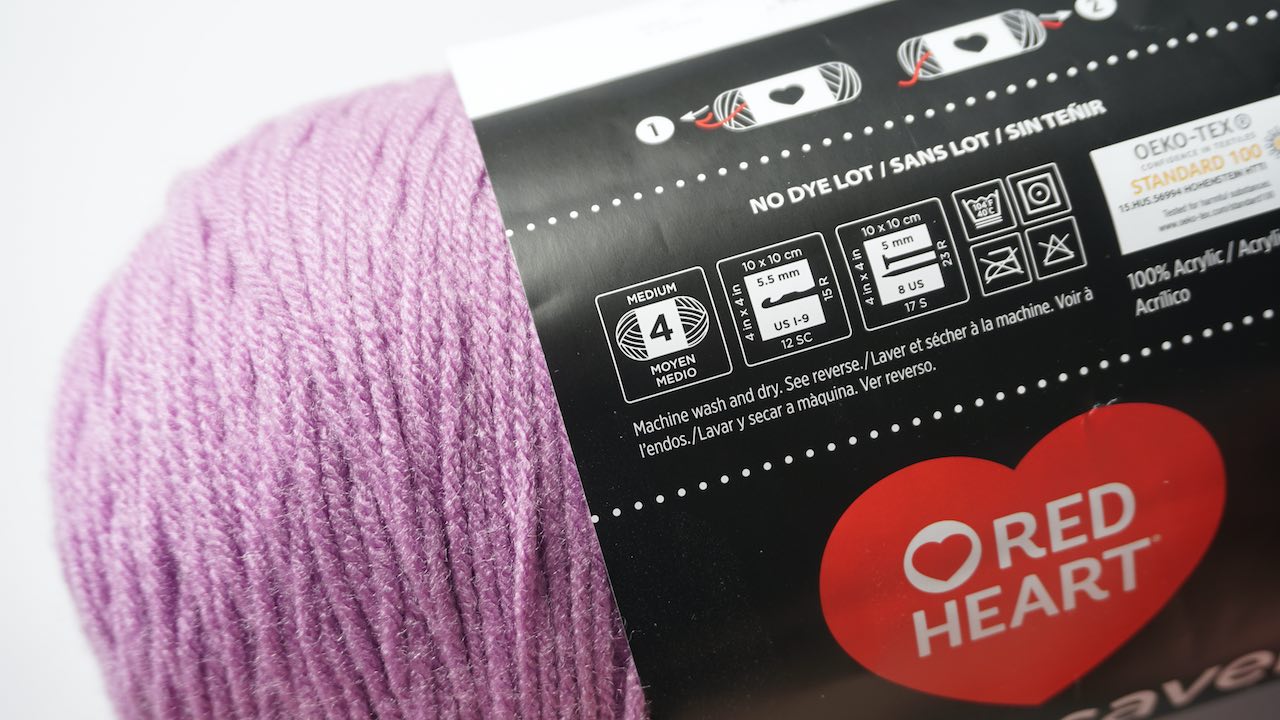
Determining the Weight of Your Yarn
The most common way to determine the yarn weight is to check the label of your yarn. The yarn weight should be listed on the ball band either as a weight category number or name.
Most yarn manufacturers use a standardized symbol system to represent yarn weight. You’ll find a small graphic on the label that depicts a number within a skein of yarn. This number corresponds to the yarn’s weight category. Sometimes, labels simply list the weight category name.
If the label is missing or unclear, you can use the wraps per inch (WPI) method to find out the yarn weight.
Wraps Per Inch (WPI) Explained
Wraps per inch, or WPI, is a common way to determine the thickness or weight of a yarn by measuring the diameter of a yarn strand.
It involves wrapping a length of yarn around a measuring tool (usually a ruler, a pencil or a WPI tool) and counting how many wraps fit within one inch of the tool. The number of wraps per inch provides an approximation of the yarn’s thickness.
If the yarn is fine, it has a higher WPI (meaning that it wraps multiple times per inch). If the yarn is thick, it has a lower WPI (meaning that it wraps less times per inch).
Wraps per inch is a helpful technique for identifying the yarn weight, especially when dealing with unlabeled or mystery yarn. By comparing the WPI count to a yarn weight chart, you can estimate the yarn’s category. This method is particularly useful for hand-spun yarns, unique fibers, or vintage yarns that don’t come with standard labels.
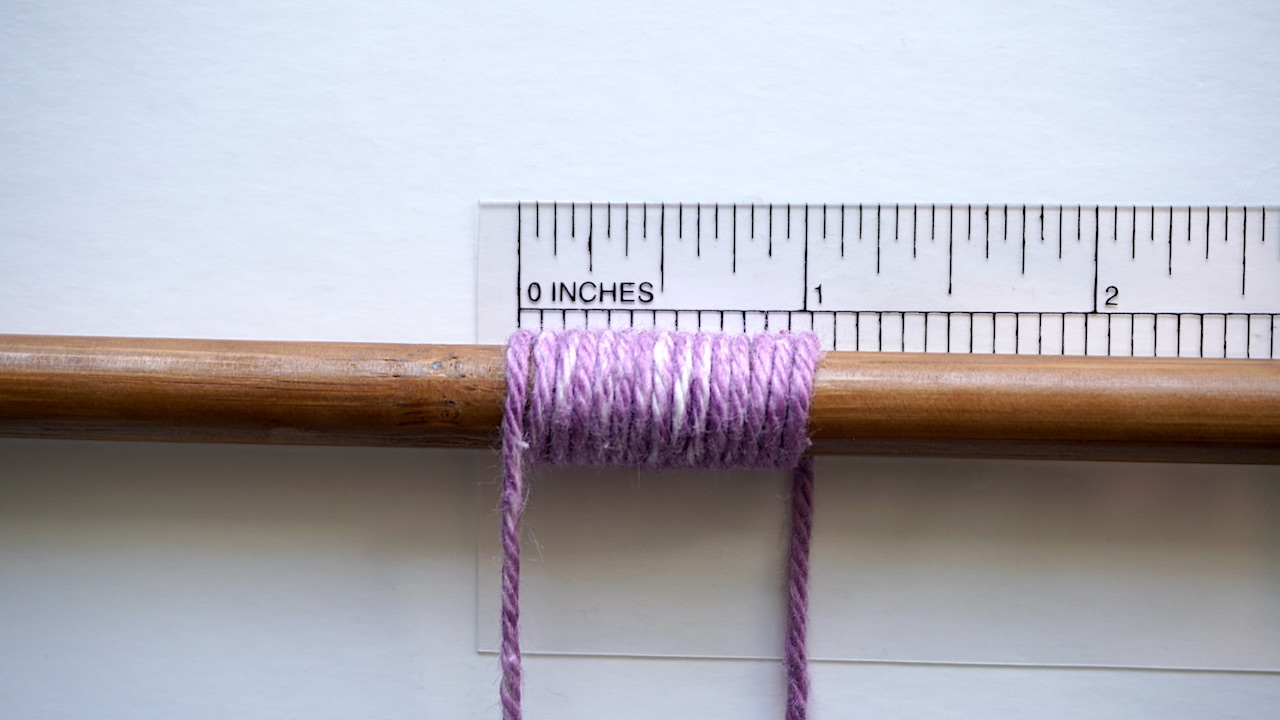
You will need a ruler, a pencil or a WPI tool to measure the WPI:
- Carefully wrap your yarn around the tool so that the strands lay snugly next to each other and do not overlap.
- Continue wrapping until the strands cover one inch.
- Count how many wraps fit into an inch.
- Compare the number of wraps per inch to the chart below to determine the category of your yarn.
To ensure the measurement is correct, don’t wrap the yarn too tightly. Try to keep the tension the same as if you were knitting. In addition, it might be a good idea to measure in several places and take an average number of wraps if your measurements differ.
Wraps Per Inch Chart
A wraps per inch yarn chart helps knitters and crocheters to determine the approximate weight or thickness of a yarn based on the number of wraps per inch when measured.
The wraps per inch chart below shows a range of WPI counts and their corresponding yarn weight categories. It helps you to identify the appropriate yarn weight when dealing with unlabeled or hand-spun yarns.
| Number of Wraps (WPI) | Yarn Weight Category |
|---|---|
| 30–40 | Lace |
| 14–30 | Super Fine |
| 12–18 | Fine |
| 11–15 | Light |
| 9–12 | Medium |
| 6–9 | Bulky |
| 5–6 | Super Bulky |
| 1–4 | Jumbo |
Yarn Weight Vs Yarn Ply
Yarn weight primarily refers to the thickness or diameter of the yarn strand. Whereas yarn ply relates to the number of individual strands twisted together to form a single yarn strand.
A single-ply consists of just one strand. Two strands are twisted together to create a 2-ply yarn, three strands are twisted together to create 3-ply yarn, and so on. In general, the higher the ply, the thicker the yarn will be.
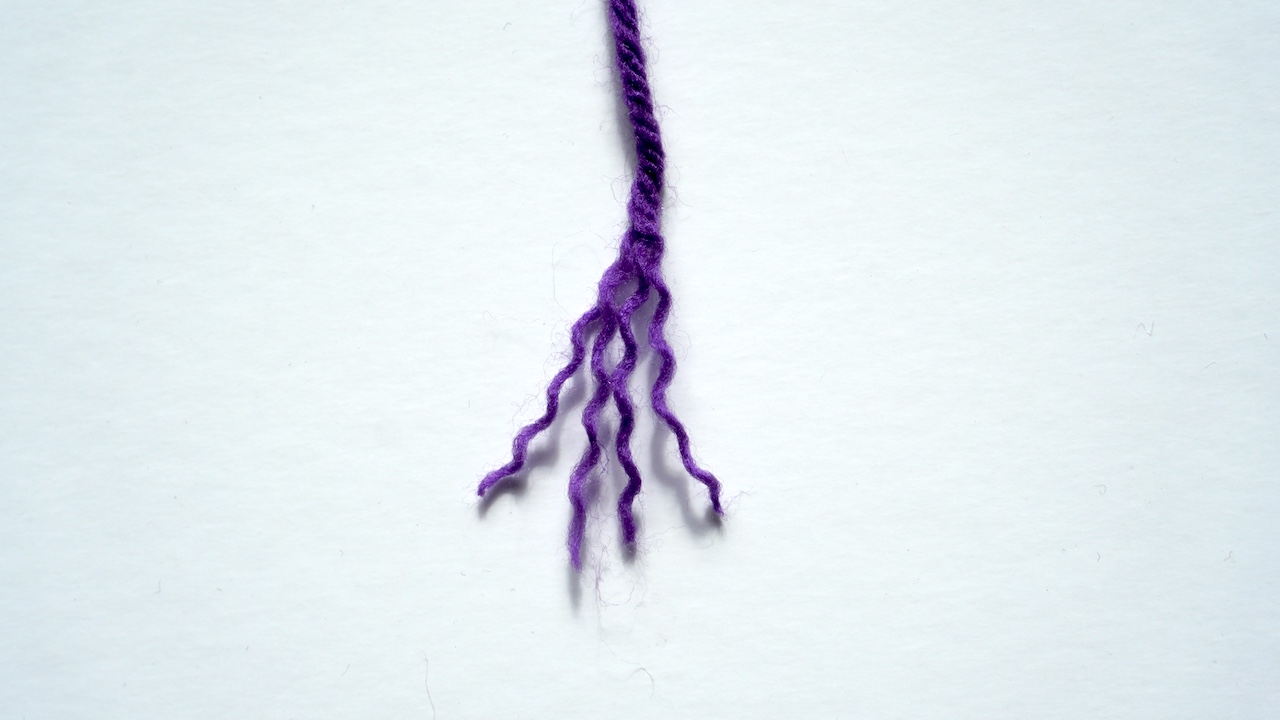
However, ply does not necessarily correspond with yarn weight or thickness. Some super bulky yarns are only two-ply and some multi-ply yarns are quite thin.
The only occasion where ply affects yarn weight is when you are comparing yarn that is made of strands that have the same thickness. In this case, more plies naturally means a thicker yarn.
So, while yarn ply and yarn weight are related in how they impact the characteristics of a yarn, they are distinct aspects of yarn construction. When selecting yarn for a project, it’s essential to consider both the yarn’s weight and ply to achieve the desired results.
Why Yarn Weight Matters
Understanding yarn weight holds significant importance for various reasons.
Primarily, it helps you choose the right yarn for your projects. Selecting the right weight ensures your project is comfortable to wear or use, whether it’s a cozy sweater or a delicate lace shawl. In addition, it ensures that your finished item matches the intended dimensions.
Moreover, yarn weight directly affects the gauge or tension of your stitches. Gauge refers to the number of stitches and rows per inch, and choosing the correct yarn weight and needle or hook size will help you to achieve the correct gauge.
Gauge is super important especially when knitting items, such as socks or garments, where it’s important that the finished size and shape are exact. Then there are projects, such as blankets and scarves, where gauge is less important as the items will still be functional even if you’ll end up with a bit bigger or smaller final piece. You can read more about knitting gauge here.
Efficiency in crafting is another aspect where yarn weight comes into play. Thicker yarns advance quickly, while finer yarns demand patience and intricacy. Understanding this allows for effective project planning, aligning the choice of yarn with project timelines.
Yarn weight also aids in substituting yarns effectively. If a specific yarn recommended in a pattern isn’t available, you can find a similar yarn in the same weight category to achieve comparable results.
In essence, understanding yarn weight is a cornerstone of successful knitting and crochet projects. It allows you to work with precision, select the right materials, and achieve the desired look and fit for your creations.
Unlocking Creative Possibilities with Yarn Weights
Combining different yarn weights opens up new possibilities for creativity. That’s where a knitting technique called double-stranded knitting comes to play.
Now don’t get intimidated by the fancy term, it simply means you knit with two strands of yarns held together. It’s simple as that! When knitting with two strands, you will be working all knitting techniques just the same way as you typically would but just two strands instead of one strand.
Double-stranded knitting is an easy technique you can use to achieve many different effects. Let’s take a closer look at the situations where you can use double stranding.
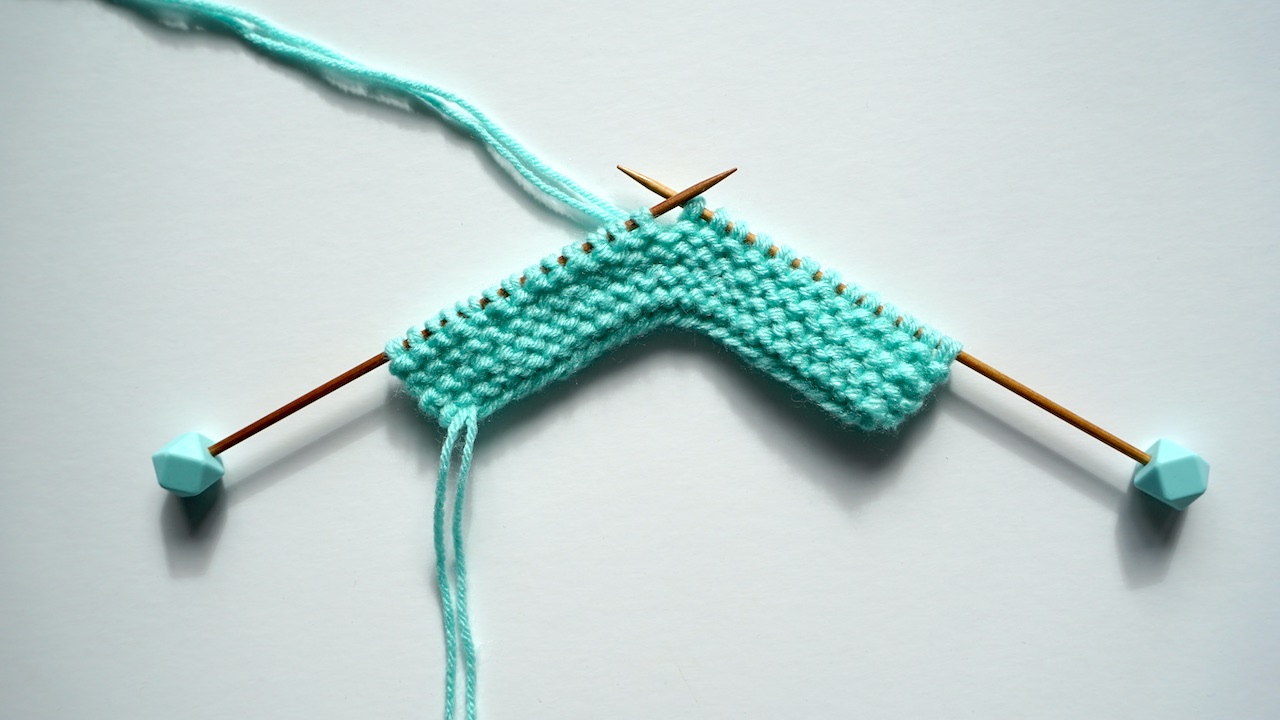
Why Use Double-Stranded Knitting
Double-stranded knitting is a great way to get a little creative and to use up your stash yarn. Here are the two main reasons where double stranding comes in handy.
Make the yarn thicker:
Have you set your mind on a certain yarn for your project or have a lots of yarn in your stash but the pattern requires a thicker yarn? No worries, you can work double-stranded knitting! You can use two strands of a thinner yarn to create a thicker yarn and to match a larger gauge. You can read more about yarn substitution here.
Change the color and/or texture:
You can play around with textures and visual effects by using a different color or type of yarn for double-stranding.
- Double-stranding same yarn in different colors:
If you use the same yarn but different colors, you will create a beautiful marled affect. You can choose similar shades to create a more subtle look or you can use contrasting colors for a bolder look. - Double-stranding different yarns:
When double-stranding, the two yarns can be of the same weight or you can combine two completely different yarn weights. If you use different yarns in same colors, you will get an interesting texture. And if you use different yarns in different colors, you will get both a marled affect and a neat texture. This technique is often used when double-strand knitting with mohair yarn.
Double-Stranded Knitting Chart
A clear understanding of how different weights interact is key when combining different yarn weights.
Generally speaking, two strands of yarn in a lower yarn weight category will give you a strand that is about as thick as one strand of yarn in the next yarn weight category.
For example, two strands of yarn in fine weight (marked as 2 on the yarn label) equals one strand of yarn in light weight (marked as 3 on the yarn label).
You can use the following yarn weight chart as a guideline when substituting different yarn weights. It shows which yarn weight a doubled yarn weight equals to.
| Two Strands of Yarn | One Strand of Yarn |
|---|---|
| Lace (0) | Super Fine / Fingering / Sock |
| Super Fine (1) | Fine / Baby / Sport |
| Fine (2) | Light / DK / Light Worsted |
| Light (3) | Medium / Worsted / Afghan / Aran |
| Medium (4) | Bulky / Chunky / Craft / Rug |
| Bulky (5) | Super Bulky / Super Chunky / Roving |
| Super Bulky (6) | Jumbo / Roving |
Please note that the information provided above is just an estimate. As there are always grades of thinner and thicker yarns within each yarn weight category, doubling the yarn weight may result in slight variations in thickness.
So always keep in mind that the actual thickness of a double-stranded yarn will vary depending on the actual thickness of the yarn you are using. AndIn addition, the needle size you use will have a big impact too. For this reason, it is important to always make a swatch to ensure that your gauge is the same as (or very close to) the gauge recommended in the pattern.
If you are using two yarns that are not the same weigh, you won’t be able to use the cheat sheet. For example, you could combine a strand of light or DK weight yarn in merino wool with a strand of lace weight mohair to create a warm and luxurious beanie or scarf. This would make around a medium or worsted weight yarn, however, you would need to make a swatch to make sure that the gauge matches the pattern.
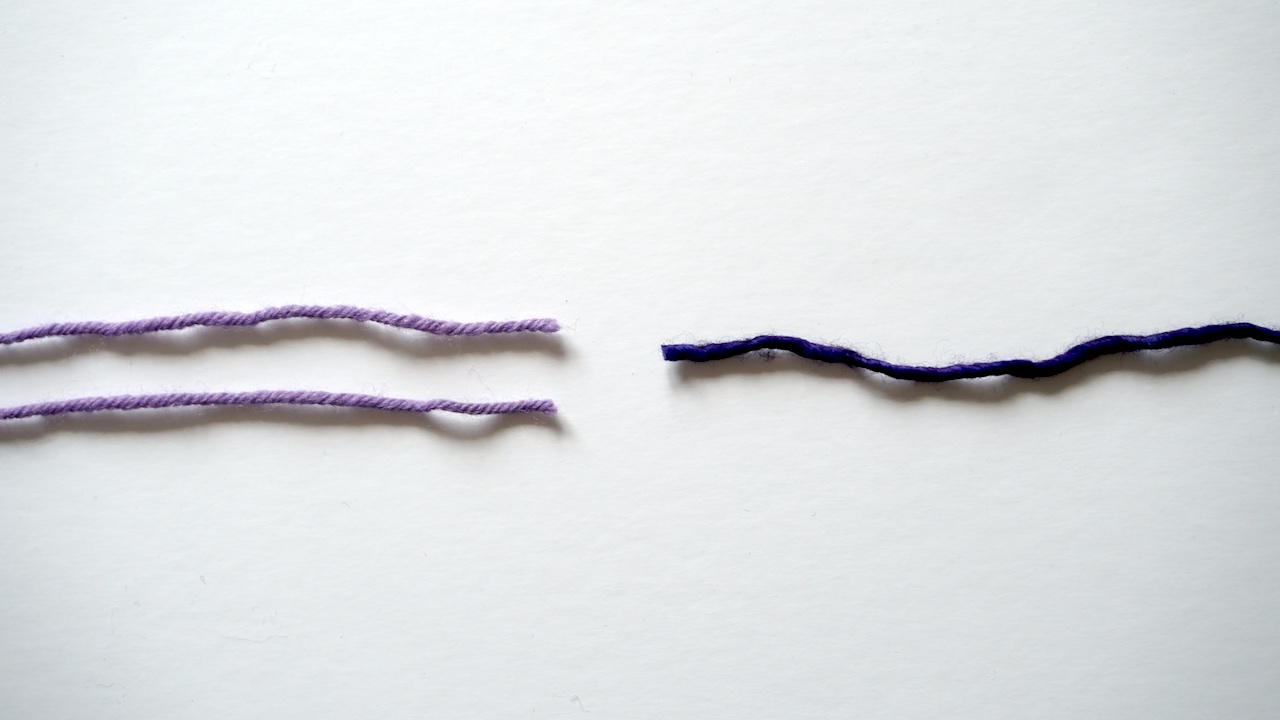
Download Your Personal Yarn Weight Chart
To make your yarn selection journey even more convenient, I’ve crafted a printable yarn weight chart. This downloadable chart offers quick access to standard yarn weight categories and other important details.
Each yarn weight category is accompanied by corresponding names and specific details to guide your choice. The knit and crochet gauges show you the recommended number of stitches per inch for that particular yarn weight. This ensures your stitches align with the intended pattern dimensions, crucial for a well-fitting final piece.
The recommended needle and hook sizes suggest the appropriate needle range in both US and metric sizes, aiding you in achieving the desired gauge and ensuring your projects maintain accuracy and consistency.
Whether you’re a seasoned crafter or just beginning your yarn adventure, this cheat sheet is an invaluable tool. It allows you to confidently select the perfect yarn for your project, even if you’re working with patterns using different regional or weight standards.
Whether you’re shopping for yarn or immersed in a project, this chart is your trusty companion. Simply download and print this cheat sheet, keep it in your crafting toolkit, and make informed decisions with ease.
| Yarn Weight Category | Corresponding Names | WPI | Knit Gauge (sts per 4 in) | Recommended Needle Size (US) | Recommended Needle Size (mm) | Crochet Gauge (sts per 4 in) | Recommended Hook Size (US) | Recommended Hook Size (mm) |
|---|---|---|---|---|---|---|---|---|
| Lace (0) | Thread, Cobweb, Light Fingering | 30–40 | 33–40 sts | 000–1 | 1.5–2.25 mm | 32–42 sts | 6, 7, 8 (Steel), B–1 (Regular hook) | 1.6–1.4 mm (Steel), 2.25 (Regular Hook) |
| Super Fine (1) | Fingering, Baby, Sock | 14–30 | 27–32 sts | 1–3 | 2.25–3.25 mm | 21–32 sts | B–1 to E–4 | 2.25–3.5 mm |
| Fine (2) | Baby, Sport | 12–18 | 23–26 sts | 3–5 | 3.25–3.75 mm | 16–20 sts | E–4 to 7 | 3.5–4.5 mm |
| Light (3) | DK, Light Worsted | 11–15 | 21–24 sts | 5–7 | 3.75–4.5 mm | 12–17 sts | 7 to I–9 | 4.5–5.5 mm |
| Medium (4) | Worsted, Afghan, Aran | 9–12 | 16–20 sts | 7–9 | 4.5–5.5 mm | 11–14 sts | I–9 to K–10 1⁄2 | 5.5–6.5 mm |
| Bulky (5) | Chunky, Craft, Rug | 6–9 | 12–15 sts | 9–11 | 5.5–8 mm | 8–11 sts | K–10 1⁄2 to M–13 | 6.5–9 mm |
| Super Bulky (6) | Super Chunky, Roving | 5–6 | 7–11 sts | 11–17 | 8–12.75 mm | 7–9 sts | M–13 to Q | 9–15 mm |
| Jumbo (7) | Roving | 1–4 | 6 sts or less | 17 and up | 12.75 mm and up | 6 sts or less | Q and up | 15 mm and up |
Conclusions
The yarn weight chart is your companion for success, making your crafting journey a whole lot smoother.
Understanding the yarn weight helps you choose the ideal yarn for your projects, ensuring that delicate lace shawl turns out dreamy and that cozy blanket is as snug as can be. Plus, it’s your secret to achieving the right gauge, so your creations are the perfect fit, no surprises.
When you’ve got that chart handy, you can swap out yarns like a pro, even when your favorite isn’t available. With it, you’ll match yarn to patterns, obtain the desired textures, and breeze through crafting with ease.
So, keep this yarn weight chart close, dive into your yarn stash, and embark on your crafting adventure with confidence.
Happy stitching!
Read also:
- Yarn 101: Types of Yarn Explained
- Complete Yarn Substitution Guide
- Knitting Needle Sizes and Conversion Chart
- A Beginner’s Guide to Types of Knitting Needles
- 6 Useful Knitting Tips for Beginners
- A Complete List of Knitting Abbreviations From A to Z
- The Knitter’s Guide to Essential Knitting Terms
- 39 Gifts for Knitters: What Every Knitter Will Want
